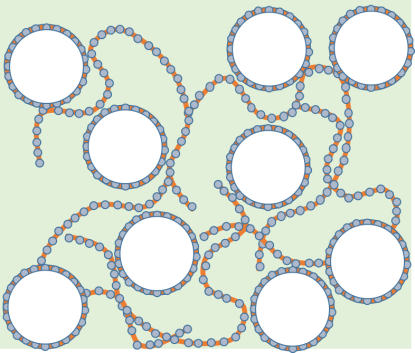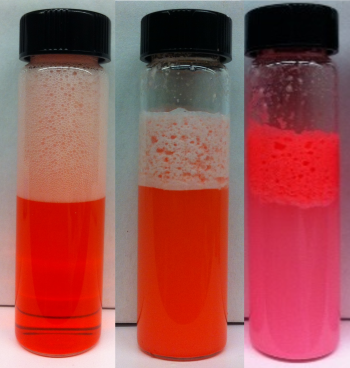Capillary Foams
Quick Start
This is a relatively new and powerful approach to making stiff foams. They are a bit like a Pickering foam, using particles to stabilize the foam walls, but they have fewer particles which are joined together via capillary action from a small amount of oil added to the foam mix. The mix itself gets viscous so you have some problems getting enough energy in to create a great foam. The technique has been developed by Behrens & Meredith1, 2 at Georgia Inst. Tech.

Step 1: Capillary attraction gives a percolated network
Put a few % (say 5% volume fraction) of fairly hydrophobic particles (the light blue circles) into water and nothing much happens. If they are a few μm diameter then they aren't strongly attracted to each other. But add a small fraction (maybe 20% of the particle volume) of a convenient oil (orange) into the water and mix thoroughly - you get a viscous liquid. This is a capillary suspension - see the app for more details. The oil forms capillary bridges between particles which form a percolated network which means that every particle has a pathway to every other particle. This means that you have a viscous suspension.
Step 2: Make the capillary foam
Now create the foam by getting bubbles (large white circles) mixed into the viscous capillary suspension with some sort of high shear mixing. This is tricky and there's an obvious trade-off between viscosity, foam creation and foam stability. A compressed-air foam (CAF) would be ideal because the viscosity doesn't matter so much. Now you get a stable foam with the particles around the air held together by the capillary bridges, but also locked in to the viscous capillary network.
Step 3: Do it efficiently
This is still a fairly recent technology (see the second paper2 for a state-of-the art review) so the rules aren't well established. Unlike Pickering foams where particles are tuned to have a specific hydrophobicity, often with a contact angle around 90°, capillary foams can be made with a wide range of particles and oils. The trick is to make sure the oil is nicely dispersed into fine drops and for it to have a medium water-particle-oil contact angle in the 60-120° range. For your specific needs, where you might be forced to use a specific type of particle or a specific oil, you will need to play around to get a good balance. And, as mentioned above, you can't make the original capillary suspension too viscous, otherwise it is hard to create the bubbles in the foam.
A bonus feature
 One lovely feature of these foams, described in the first paper1, is that if you add some dye to the oil then the foam is brilliantly coloured because most of the oil is swept up at the air interface. It has never been possible to get brightly coloured foams before! The image, courtesy of Behrens & Meredith, shows foams from the same coloured oil, but standard (surfactant) on the left, Pickering in the middle and Capillary on the right.
One lovely feature of these foams, described in the first paper1, is that if you add some dye to the oil then the foam is brilliantly coloured because most of the oil is swept up at the air interface. It has never been possible to get brightly coloured foams before! The image, courtesy of Behrens & Meredith, shows foams from the same coloured oil, but standard (surfactant) on the left, Pickering in the middle and Capillary on the right.
1Yi Zhang, Michael C. Allen, Ruiyang Zhao, Dimitri D. Deheyn, Sven H. Behrens, and J. Carson Meredith, Capillary Foams: Stabilization and Functionalization of Porous Liquids and Solids, Langmuir 2015, 31, 2669−2676
2Omotola Okesanjo, J. Carson Meredith, and Sven H. Behrens, Structure−Property Relationship in Capillary Foams, Langmuir 2021, 37, 10510−10520


